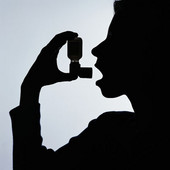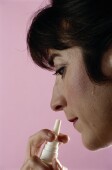| 
Obesity May Worsen Impact of Asthma
 THURSDAY, May 1 (HealthDay News) -- A study of women with a wide range of body-mass indexes (BMIs) found that obesity may worsen the impact of asthma and also mask its severity in standard tests.
"We have demonstrated significant differences in the changes in respiratory function that occur with asthmatic bronchoconstriction in relation to obesity," principal investigator Dr. D. Robin Taylor, of the University of Otago in New Zealand, said in a prepared statement.
The study also found that simple spirometry couldn't determine the level of pulmonary dysfunction in obese people with asthma.
The findings were published in the first issue for May of the American Journal of Respiratory and Critical Care Medicine. It's the first prospective study to find a significant comparative difference between obese and non-obese people in how the lungs and airways respond to a simulated asthma attack.
The researchers said it establishes a direct link between obesity and the development of dynamic hyperinflation -- air breathed into the lungs can't be expelled. This often occurs with acute asthma, but is more frequent in obese people.
The study included 30 asthmatic women who were divided into three groups based on their BMI: normal weight, overweight and obese. All the women breathed nebulized methacholine to induce an asthma-like attack and were then assessed for changes in lung function, including functional residual capacity (FRC -- how much air remained in the lungs after exhalation) and inspiratory capacity (IC -- how much air could be inhaled on the next breath).
"After the methacholine challenge, the amount of bronchoconstriction was identical for each of the three groups, but the changes in FRC and IC were greatest in the obese group. This indicated to us that greater dynamic hyperinflation was occurring among obese individuals," Taylor said.
The greater a woman's BMI, the higher her FRC and the lower her IC.
"This means that among women with greater BMI, an asthma-like episode has the potential to cause greater breathing difficulties than in non-obese women. The greater dynamic hyperinflation means that obese individuals lose the ability to inhale as deeply or exhale as fully as normal weight individuals," Taylor said.
The findings suggest fundamental differences in the way that obese people with asthma may experience shortness of breath.
"We know that asthma in obese subjects is more likely to persist and is more likely to be perceived to be severe. These individuals often require more treatment to achieve asthma control. Our study provides an insight into why this might be happening -- the same asthma trigger produces a greater effect in obese individuals," Taylor said.
More research is needed to "confirm that the differences in dynamic hyperinflation between obese and non-obese asthmatics are sufficient to explain the differences in symptoms between the two groups. Our study was not large enough to do this," Taylor said.
More information
The U.S. National Heart, Lung, and Blood Institute has more about asthma.
|  |

Nasal Irrigation Can Help Fight Spring Allergies
 SUNDAY, May 11 (HealthDay News) -- When you're doing your spring cleaning, don't forget your nose.
Nasal irrigation is a cheap and easy way for people with spring allergies, nasal congestion, stuffy noses and post-nasal drip to get relief, says Dr. Melissa Pynnonen, co-director of the Michigan Sinus Center and an assistant professor in the University of Michigan's department of otolaryngology.
Nasal irrigation involves rinsing the nose and nasal passages with a solution made with a quarter-teaspoon of kosher salt, eight ounces of warm tap water and a quarter-teaspoon of baking soda.
There are a number of ways to administer the solution. For people who've never done nasal irrigation, Pynnonen recommended using an eight-ounce squeeze bottle and squirting four ounces of the solution into each nostril. The solutions exits through the opposite nostril. Opening your mouth and making a "K" sound will prevent the solution from coming out of your mouth.
Some people use a neti-pot, which looks like a miniature teapot. When using a neti-pot, the solution is poured, rather than squeezed, into the nose. Turkey basters or syringes like those used to suction a baby's nose also work.
"For most patients, the benefit of nasal irrigation is that it does a great job of treating symptoms that otherwise aren't well treated with medicine," Pynnonen said in a prepared statement. "Nasal irrigation can be considered a first-line treatment for common nasal and sinus symptoms. It's often more effective than medications," she concluded.
Nasal irrigation alone may be sufficient to control mild allergy symptoms in some people, but others may need to used medications in addition to nasal irrigation.
So long as children are old enough to cooperate, it's safe to give them nasal irrigation, using a smaller amount of solution, Pynnonen said.
More information
Queen's University in Kingston, Ontario, Canada, has more about nasal irrigation  . .
|  |

Health Tip: Facts About Hay Fever
(HealthDay News) -- Hay fever is the medical term for a pollen allergy, and may also be called seasonal allergic rhinitis or pollinosis.
Here are other facts about hay fever, including suggestions to reduce symptoms, courtesy of the American Lung Association:
- Symptoms often include congestion, red and watery eyes, sneezing, runny nose, and itchy eyes and ears.
- Many people who have hay fever develop asthma.
- Hay fever is more common during certain times of the year in different regions, depending on seasonal pollen counts in those areas.
- Symptoms may be reduced by limiting exposure to the outdoors. Use air conditioning and air-purifying devices, stay inside, and wear a dust mask if you have to be outside.
- Antihistamines and decongestant medications can help control symptoms.
|